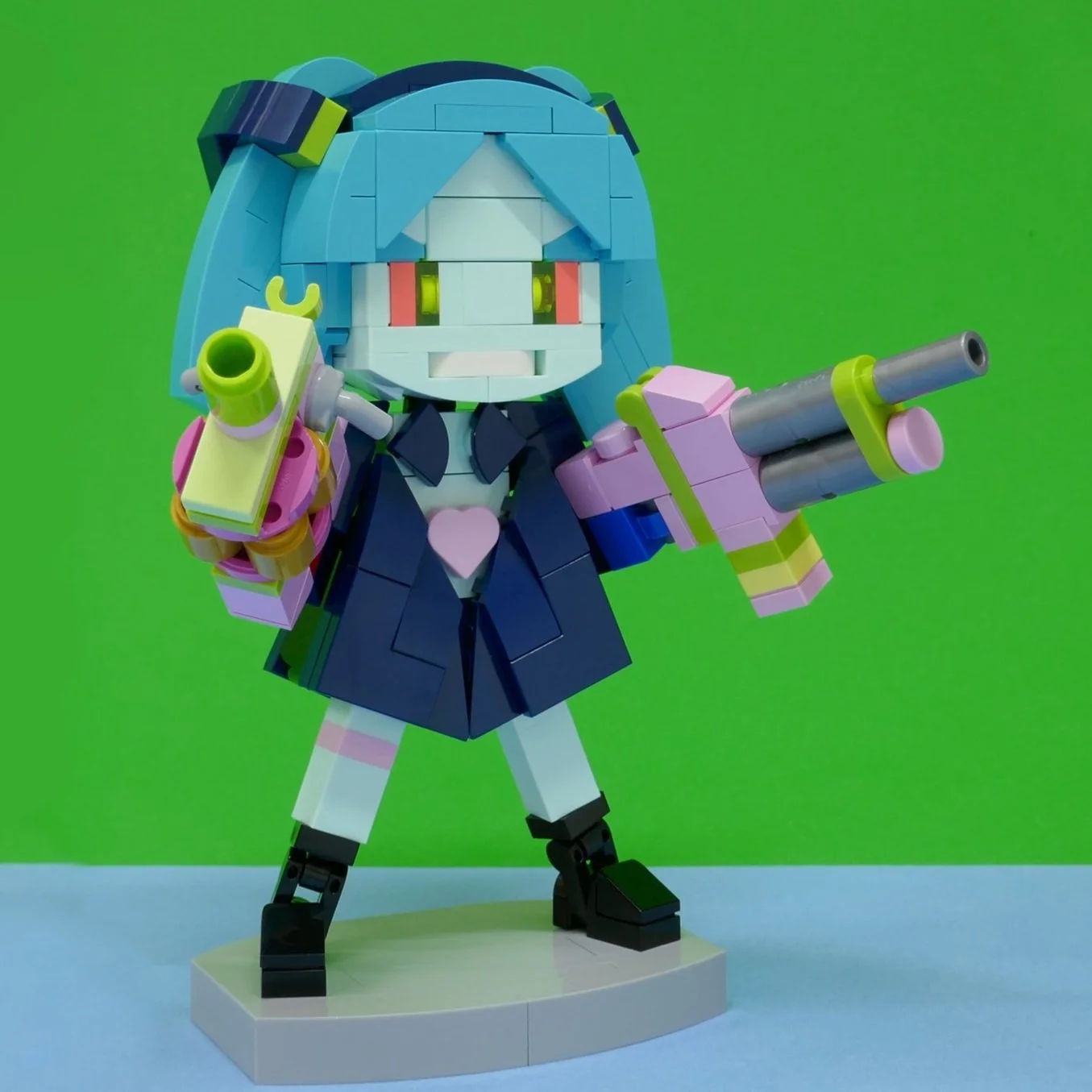The Secret of the Old Dutch Villa in the Masterpiece Gallery
/Our previous conversation with Victor van den Berg gave us an unforgettable impression of his giant old castles with high-class realism. Victor recently had the opportunity to visit LEGO House in Denmark where his breathtaking Old Dutch Villa is on exhibit in the Masterpiece Gallery.
We got to chat with him about the build and the LEGO House.
An Invitation to LEGO House
Ann: Hi Victor! Congratulations on this wonderful achievement! So glad to welcome you again on BrickNerd and excited to find out more about your gorgeous creation.
Victor: Hello Ann, I’m happy to be back at BrickNerd. Some things have changed since the previous interview: I started a business to build with LEGO at schools and that is really going well. Shortly after I started this company, I received the invitation from LEGO House to display at the Masterpiece Gallery. So it was an exciting but busy year!
Ann: How did you come to be invited to exhibit at LEGO House?
Victor: It was last summer that I received an email from someone at LEGO House who said that my buildings really stood out and that they had decided that I could exhibit at the Masterpiece Gallery. At first, I laughed at this email and thought it was a scam or someone was playing a funny prank. I actually didn’t think about it that much, but after a few days I did some more research. To be honest, I had never heard of the Masterpiece Gallery, but after a few searches, I found a lot about it.
What was striking was that only 15 people were selected for this honor. So, I thought it was some kind of competition that you had to participate in. At that point, I had demolished all my buildings and had nothing to contribute. But it soon turned out that after answering the email, I received a response that there was no competition. It seemed like a done deal that I could place a structure for a year in Home of the Brick: LEGO House.
I had a few months to start making something. And I had to make something really good. Something so good that it was worthy of being seen by several hundred thousand people. I stayed calm and tried to take it easy.
It slowly dawned on me that this was an incredible opportunity being given. Apparently, the LEGO House team spends a year tracking down hundreds of people worldwide who build very well, from which 15 people are selected who will ultimately receive this enormous honor. A kind of dream that then becomes reality. And it still seems a bit surreal. What more could one wish for as a LEGO builder?
I really had to get to work. I was really looking forward to making something fantastic because it had been some time since I had made something big and challenging for myself.
Planning a Build for LEGO House
Ann: What was your process like designing something from scratch for LEGO House?
Victor: I started with a plan. The LEGO House team had seen my builds on the internet and social media channels—most of them were castle-like rooms. So I figured I had to make something like that.
I started by searching through the pictures I keep of real castles. Nowadays, there are also many AI-generated pictures. I found a photo of a castle interior with many stairs which immediately fascinated me. I started from there, and I’d see how it turned out once I started building.
I had a lot of help from my wife of course. While my mind was busy building, she arranged everything for the transportation, hotels and other logistics.
My wife and decided to drive to Billund by car because we were not sure whether the enormous MOC would arrive in its entirety if we went by plane. A box had to be made so that the structure fit nicely and was safe for transport. A friend of ours is a carpenter, and he made a box that allowed the build to fit perfectly. Upon arrival at LEGO House, only two pieces of the structure had fallen off, so it was a good idea to do it this way.
The LEGO House Experience
Ann: What were your impressions of LEGO House?
Victor: First of all, a compliment to the LEGO House team: not only is everyone really very social and nice, but they really took care of us, making sure everyone was comfortable. The LEGO House was closed to the public so that the set up of the Masterpiece Gallery could be undisturbed.
There were journalists that day who wanted to see and know everything about the Masterpiece Gallery in order to have the first scoop. There were plenty of cameras to be found in between construction, which, of course, provided nice pictures of the builders who were building their beautiful works of art.
And what beautiful works! For me personally it is a huge honor to be part of this chosen group with so much talent!
It was nice that we [the exhibitors] could wander freely through LEGO House without any other people. We also were given a tour by the Master Builder Stuart Harris who gave us the inside scoop on LEGO House. After all this, we also had dinner at the building and received many very special LEGO presents.
The next morning the concierge at the desk in the hotel spoke to me and said that she had seen me on Danish national TV that evening and recognized me.
That same morning was when the Masterpiece Gallery was opened to 600 LEGO fans. So, this day too we exhibitors spoke to a lot of people and took pictures with them. In the moment I thought to myself, “This is something very special I’ll probably only experience once in my life.” You don’t think of things like that when you’re building at your living room table at home.
Every now and then I receive messages from acquaintances and strangers who have just seen my building during a visit to the LEGO House. My wife and I enjoyed the experience and have really wonderful memories of it!
Constructing the Old Dutch Villa
Ann: The Old Dutch Villa reflects not only your expertise with parts usage but also your great research in the area of architecture. How many real-life places form the basis for your villa? How long did it take to develop the build based on your inspirations and references?
Victor: It took me about a week to do my research. I searched the internet for castles and their interiors and then collected all kinds of ideas that I could hopefully integrate into the building. It was clear that there should be many stairs, many doors, ornaments, windows, statues, a fireplace, a striking floor and furniture. And there had to be several floors that all had to connect with each other. As if I was nervous before I actually started building, what needed to be done now seemed daunting—the kind of feeling that you can’t go back anymore.
Luckily I had a few weeks of vacation time. Once you start building, you know it won’t stop until it’s finished. I had planned to walk in nature for a few hours every day before I started to build to get calmer, to think and get some exercise.
My builds always have lots of details for viewers to see. I often count the number of striking features. The goal is to get above ten things that catch the eye or something innovative for the viewer. And because this really had to be a masterpiece, many more novelties or eye-catchers had to be included. While building I regularly looked for any interesting things I could possibly add.
The construction of the whole building took two months; every day something arises that you come up with or that you want to adjust. Of course, I didn’t have all the pieces at hand, so sometimes you have to wait for the mail until something arrives. And sometimes what was planned to be constructed didn't work with the pieces I ordered. Plans change. I used pieces that were better or found a new and superior reference for a model—everything can change. That’s also the fun of the building time.
Designing the Clock and Lots of Furniture
Ann: How many real-life places form the basis for your villa? Is the clock based on one you saw before?
Victor: Between 10 and 20. Sometimes it’s just an idea or element that you can develop further on your own. I don’t remember why I wanted to build the clock on the outside facade. I remember looking on the internet to see if such a thing existed. A large clock with figures in it and day and night.
I knew there were clocks with all these intricate features, but I couldn’t find much online beyond a few simple clocks. The astronomical clock in Prague was the closest, but I wanted something slightly different. Finally, I came up with the build as it is now, and I was pleasantly surprised! The nice thing was that one of my 5-year-old nieces knew exactly what the difference between day and night represented when her mother showed her a photo of it. So mission accomplished. I feel like it worked out very well with a lot of other elements too.
Ann: The clock is very innovative! I absolutely love the design of the tables in front of the sofas and armchairs. There are so many tiny accessories. What are your favorite objects and parts of the castle?
Victor: The real fun is always making the furniture. I never know in advance how that will turn out, but as soon as they’re inserted into the build, the whole room suddenly comes to life. At that moment I can suddenly imagine who the residents are. And what they see when they sit on the couch or chair. I also start thinking about how I’m going to decorate the rest of the room. And it suddenly becomes clear what the scale of the room will be. Actually, just like when furnishing a real house. Maybe I should have become an interior designer!
I only had certain colors for the sofa and chair that you might not use in this interior. My plan was to just make the furniture with what colors I had and then replace them later with colors that were better. But it turned out just right, and the bright colors made the furniture stand out perfectly. I was pleasantly surprised!
When you look at castles and their interiors, you inevitably come across spiral stairs. I really wanted these to be included. I started experimenting with stair designs and thought it was a really nice challenge to make it sturdy, to make the colors match the whole, and, above all, to ensure that the rotation would ultimately connect it to the right height of the floor. It worked perfectly, and once again, it’s a great feeling to see that your idea turns out well. I really enjoy that.
Ann: How did you create the look for the outside of the model?
Victor: When the interior was mostly finished, I started thinking about what should be done on the outside. My preference for Dutch 17th century houses could be put to good use here. I kind of took a break from building the interior and started researching what I could make there. I live nearby the old and beautiful city of Delft and when I visited the city one day I saw a lot of things on the old buildings which I incorporated into the build.
I thought it would be perfect if you could see into the building the windows so it had to fit exactly together, and that was quite a challenge, but finally, I succeeded in this. That was also a victory because I had never built a complete interior and exterior in one build.
Just about everything in the Villa is a favorite of mine. All the elements of the build are ideas that have worked out well one by one and look great as a whole. What I like for those viewing the build is that the longer you look or take your time, the more and more details you will see. Or even better imagine that you could make yourself small and walk around this building and look at everything at your leisure. I looked at it this way myself while building it and I hope that some people do the same this way. Especially for those who love these types of builds, I hope I can inspire them.
The Old Dutch Villa’s History and Scale
Ann: Do you have any ideas in your mind as to who has lived in the villa, past or present?
Victor: Although the build is supposed to represent a 17th-century building, I still wondered during the construction process whether it would be a building that was inhabited in our time. The only clue I wanted to give was the lamp, which should show that the thing works on electricity so that the residents are from the modern era.
I hope that when someone looks at this, he or she imagines who could live here or that it could be yourself and what you would see every day. It would be something to live there right?
Ann: Indeed! Is the Old Dutch Villa the largest LEGO build in your collection?
Victor: This is indeed my largest build to date, and it was by far the most fun I have ever had, and the build I am most proud of. It challenged me to make something truly special: to create an exterior for the interior, to use all the tricks I know, and to make something really big that would also be looked at critically by thousands of people. Everything had to be right and on the right scale. I basically had to outdo myself with everything I had built so far.
Two months after I’d finished the Old Dutch Villa, I missed building it and started thinking about expanding it, to surpass the level of craft I put into Villa. I found myself busy figuring out what would be behind all those doors. Eventually, I even started drawing how I could expand the building. It included a dining room, a kitchen, and a courtyard, and I can already see that now. Something for the future? Who knows?
Ann: The story of the Old Dutch Villa continues! Very intriguing! Thank you so much for this conversation, Victor. We’re happy for you and congratulate you on your great achievement!
Victor: I want to thank you and BrickNerd for this opportunity to talk about my build and the exhibition at LEGO House! I wanted to end with my quote which is on the wall of fame in LEGO House: “Keep building, keep dreaming. Everything is possible.”
Have you seen the Old Dutch Villa? What was your experience at the Masterpiece Gallery like? Let us know in the comments below!
Do you want to help BrickNerd continue publishing articles like this one? Become a top patron like Marc & Liz Puleo, Paige Mueller, Rob Klingberg from Brickstuff, John & Joshua Hanlon from Beyond the Brick, Megan Lum, Andy Price, Lukas Kurth from StoneWars, Wayne Tyler, LeAnna Taylor, Monica Innis, Dan Church, Roxanne Baxter, and Steven Laughlin to show your support, get early access, exclusive swag and more.

































